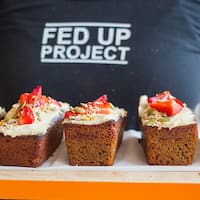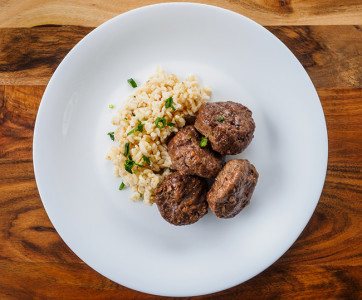Whether you are already a fruit, vegetable and earth-loving nutrition guru or you're working on improving the amount of fibre, vitamin and macronutrient rich foods in your daily meals, I've got you covered. The 5-Minute Salad Lunchbox has a whole bunch of kickass ideas around combinations of flavours and colours to make your lunch delicious, satiating and balanced. Far from bland or insubstantial, as sometimes salad can be, these recipes have a protein, fibre-rich vegetables or pulses, and flavour rich seasoning that will keep you satiated for hours. Eating healthily is not about compromising what you actually enjoy and want for something you feel you should have. This is about discovering meals and foods you DO enjoy and that you DO want, recognising that foods that are good for you are also freakin' delicious once you start experimenting and realising you can have so many things you hadn't factored into a healthy diet and really enjoy them. Sometimes, exchanging full fat butter for nut butters, or using roast vegetables and crunchy roasted chickpeas in place of chips and starchy, processed burger patties can be a revelation.
Without further ado, the recipes. What are you going to make this week? Let me know on Facebook.
Without further ado, the recipes. What are you going to make this week? Let me know on Facebook.
LEFT-OVER
ROAST VEGETABLE SALAD
Substitute toasted pine nuts or
almonds if you don’t have cashew nuts.
200 g (7 oz) left-over roast vegetables, such as carrot, pumpkin
(winter squash), parsnip, potato, sweet potato and beetroot (beets), sliced or
cut into bite-sized pieces
2 large handfuls of baby English spinach leaves
small handful of parsley leaves, roughly chopped
30 g (1 oz) cashew nuts, roughly chopped
2 teaspoons sumac
TAHINI DRESSING
1 teaspoon minced garlic
2 tablespoons tahini
juice of ½ lemon
1 tablespoon water
salt and freshly ground black pepper, to taste
1.
Toss the salad ingredients
together, then tip into your lunchbox.
2.
Combine the dressing ingredients
in a small jar or container with a tight-fitting lid.
3.
Pour the dressing over the
salad just before serving and toss well.
LENTIL,
HALOUMI & HERB SALAD
Cat's Note: as a vegan, I substitute vegan haloumi or chickpea tofu for the halouomi in this recipe. There's also nut-based vegan "cheese" or you could fry some tofu or add tempeh instead.
50 g (1¾ oz) slice of haloumi, fried in hot oil for 3 minutes, cubed * vegan halloumi recipe
150 g (5½ oz/⅔ cup) drained tinned brown lentils
1 tomato, diced
handful each of mint, parsley and coriander (cilantro), chopped
LEMON & CUMIN DRESSING
juice of ½ lemon
1 teaspoon ground cumin
2 tablespoons extra virgin olive oil
salt and freshly ground black pepper, to taste
1.
Toss the salad ingredients
together, then tip into your lunchbox.
2.
Combine the dressing
ingredients in a small jar or container with a tightfitting lid.
3.
Pour the dressing over the
salad just before serving and toss well.
RAW
BRUSSELS SPROUTS WITH PEAR, HAZELNUTS & PECORINO
The sweetness from the pear
and cranberries (also known as craisins) are the perfect foil for the peppery
bite of the raw brussels sprouts. Apple will work just as well as pear and,
while the hazelnuts bring something really special to this salad, walnuts are
great here, too.
Cat's Note: as a vegan, I don't add pecorino but if you want an alternative, there's a cashew based vegan cheese alternative below.
150 g (5½ oz) brussels sprouts, shredded
1 pear, thinly sliced
30 g (1 oz) roasted hazelnuts, roughly chopped
30 g (1 oz/⅓ cup) grated pecorino
2 tablespoons dried cranberries
small handful of parsley, roughly chopped
CIDER VINEGAR DRESSING
2 teaspoons dijon mustard
1 teaspoon honey
1½ tablespoons apple cider vinegar
2 tablespoons extra virgin olive oil
salt and freshly ground black pepper, to taste
1.
Toss the salad ingredients together,
then tip into your lunchbox.
2.
Combine the dressing
ingredients in a small jar or container with a tightfitting lid.
3.
Pour the dressing over the
salad just before serving and toss well.
Vegan parmesan cheese
ingredients
- 1 cup unsalted cashews (150 g)*
- 4 tbsp brewer’s or nutritional yeast
- 1 tsp fine sea salt
- 1 tsp garlic powder
instructions
- Grind all the ingredients in a grinder or food processor until well mixed.
Extracted from THE
5-MINUTE SALAD LUNCHBOX by Alexander Hart, published by Smith Street Books,
RRP AU$24.99 or NZ$28.99 Photography
© Chris Middleton / Food styling © Deborah Kaloper.































